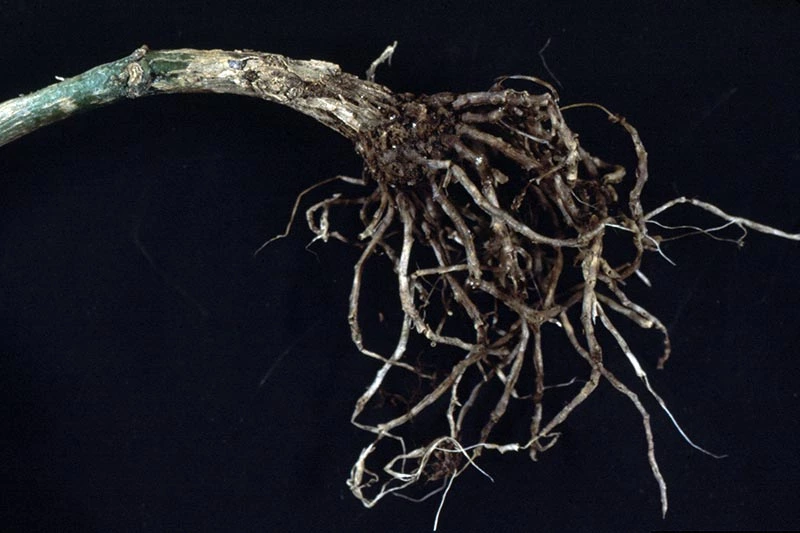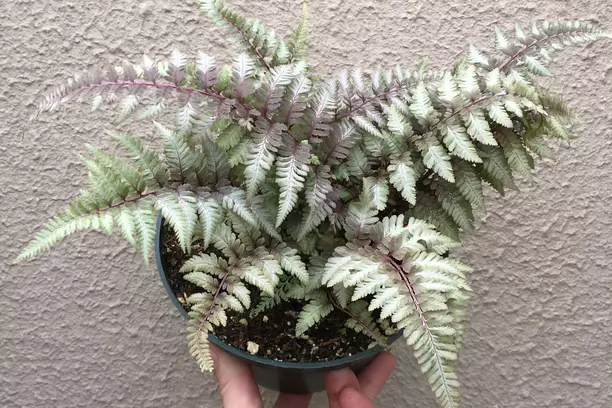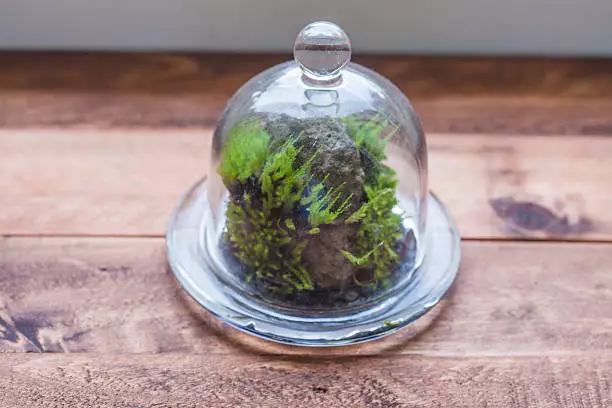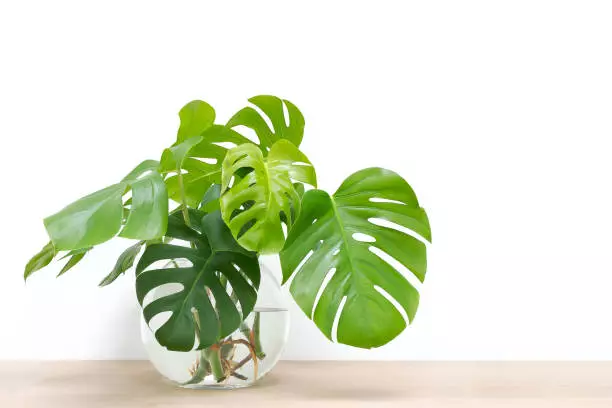Herbs are a great addition to your garden as they can be used for many different purposes. You can use them for kitchen recipes, herbal remedies, crafts, and any other purposes. Herbs with purple herbs are not only beautiful but they can also be put to so many other uses in the home.
Purple-flowered herbs
Here, are 15 lists of the most common herbs with purple flowers with details such as their growing conditions, uses, and other aspects. Some of the herbs include lavender, chives, sage, rosemary, and catnip to mention but a few.
1. Lavender
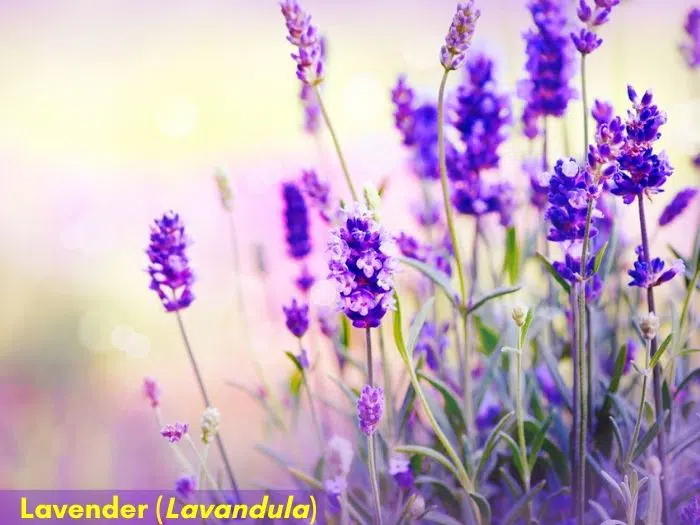
Lavender is a popular herb also called Lavandula and is in the mint family. It’s a herb native to Africa, Europe, and Asia and flourishes in any well-drained soils, especially in temperate climates. They have many small, spike-like purple flowers growing on their long narrow stems.
Here’s important information on growing and caring for lavender:
| Names | Lavender; Lavandula ssp. |
| Sunlight requirements | Full sunlight exposure |
| Soil | Well draining; 6.5 to 7.5 pH range |
| Blooming season | Spring to late summer |
| USDA Hardiness | Zones 5 to 9 |
Lavender blooms in the summer but some varieties start flowering in the spring and can continue to do so until late summer. The herb produces purple flowers that last 4 weeks to 3 months depending on the variety.
English lavender herbs bloom for the shortest period, with the blooms lasting only 4 weeks. French lavender blooms last the longest, usually up to 3 months starting in May in the spring. These flowers last until fall.
Lavenders are some of the best flowers that attract leaves and butterflies, making them a very good pollinator in your garden. The plant is also a natural pest repellent and can be used to repel deer as well.
Lavender has many different uses among them the following:
- The flowers are used to represent grace, beauty, calmness, caution, purity, devotion, silence, and royalty.
- It’s used as a fragrance.
- Production of lavender essential oil that has antiseptic and anti-inflammatory properties.
- The lavender essential oil also improves hair growth.
- Reduces menstrual pain.
- Relaxes the mind against anxiety.
- Reduces pain and swelling in canker sores.
- Aids in blood circulation.
- Lavender flowers (dried and fresh) and lavender oil are used for cooking.
- It’s used with champagne, salads, and as an ice cream garnish.
Lavender blooms in the early spring and continues blooming all through the summer. Some lavender species bloom again in the late summer. You can encourage the blooming by removing the flower spikes. The most common types of lavender plants include Spanish lavender, French lavender, English lavender, and hybrid lavender.
Lavender’s growing conditions are as follows:
- Soil pH – basic
- Water – Irrigate twice a year
- Light – good natural light
It’s possible to grow lavender indoors as long as you provide the needed lighting and soil conditions. In general, it’s easy to grow lavender, especially in the right climate. You can grow it with other herbs since it has the benefit of drawing pollinators to the garden.
2. Rosemary
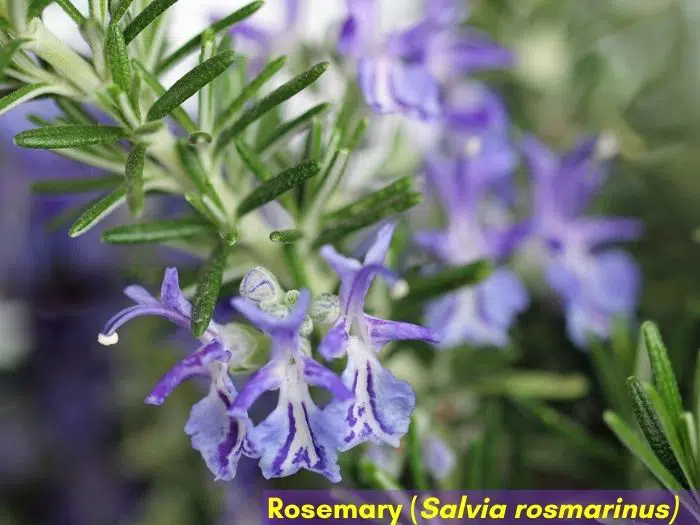
Another herb with purple flowers is the perennial Rosemary. It has needle-like leaves that are evergreen and have a pleasing fragrance. Besides the purple, rosemary flowers also come in white, pink, and blue colors.
Rosemary plants bloom in the spring and can last up to late summer. However, the plant also tends to flower outside its usual blooming season with some producing flowers as early as mid-February and as late as December.
The herb is native to the Asian and Mediterranean regions and can grow to about 4 feet in height. Its leaves can grow to about 4cm long and up to 5mm wide. It’s a hardy plant that can survive harsh conditions with a lack of water for quite a long time.
| Names | Rosemary; Salvia rosmarinus |
| Sunlight requirements | Full sunlight exposure |
| Soil | Well draining loam; 6.0 to 7.0 pH range |
| Blooming season | Spring to late summer |
| USDA Hardiness | Zones 9 to 11 |
Some of the uses of this herb include the following:
- It’s used to control pests both in the home and in the garden.
- To decorate gardens and other areas.
- Decorating other areas such as gift wrapping, table settings, wreaths, and holiday décor.
- Food flavorings for stuffing and roast meats.
- Helps in enhancing memory and concentration.
- Helps prevent macular degeneration.
- Having lots of antioxidants and anti-inflammatory properties, rosemary is used to improve circulation and immune systems.
- It has carnosic acid which helps protect the neurological system.
- Helps reduce or prevent the aging of the brain.
The growing conditions for rosemary are as follows:
- Sunlight – 6 to 8 hours of direct sunlight.
- Drainage – well-drained soil with sand preferred.
- Air – good air circulation.
- Fertilizer – is not needed.
Growing your Rosemarys is quite easy if you’re in the right climate.
3. Catnip
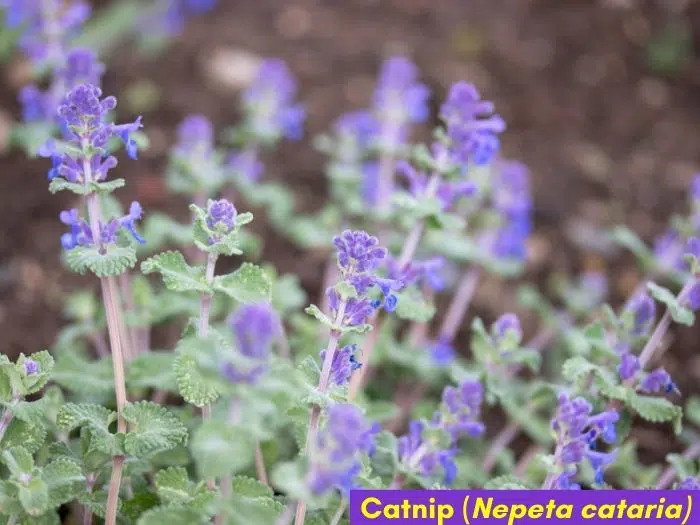
Also called catwort, catswort, catmint, and Nepeta cataria, the catnip herb is a minty plant native to China, the Middle East, Central Asia, and Eastern and Southern Europe. It can grow to 100 cm in height and is perennial in nature. You can recognize it with its square stems with leaves that are brown-green in color and elliptical or triangular in shape.
Some of the uses for this herb include the following:
- It Aids the digestive system.
- Has antiseptic properties which are beneficial to the hair and scalp.
- Fights off infections.
- Alleviates stress and aids sleep.
- Eases cramps and fever.
- Improves sweating and loss of weight.
The growing conditions for catnip are as follows:
- Sunlight – full to part sunlight.
- Soil types – well-drained but a variety of soils.
- Fertilizer – little to no fertilizer.
Of note is the fact that this herb shouldn’t be fertilized as fertilizer reduces the potency of the smell of its flowers.
4. Anise Hyssop
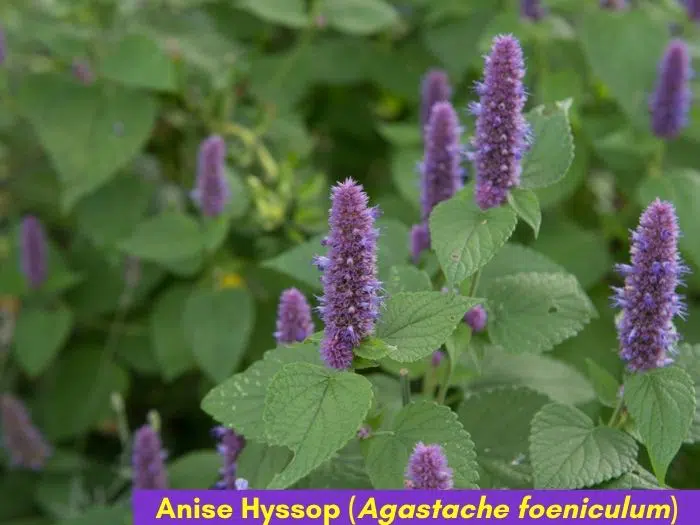
Also called blue giant hyssop, fragrant giant hyssop, or the lavender giant hyssop, this herb has purple flowers that appear in showy verticillasters or false whorls. It’s a herb native to North America and can grow to a height of 120 cm and a width of 30cm. You can tell it apart with its upright and clump-like shape.
Some of the uses for this herb include the following:
- Salad garnish.
- Flavoring desserts, soups, and pasta.
- Treatment of fevers, diarrhea, wounds, and coughs.
The growing conditions are as follows:
- Sunlight – full sunlight to part shade.
- Soil – well-drained.
It’s quite easy growing this herb since it’s resistant to drought and deer as well.
5. Oregano
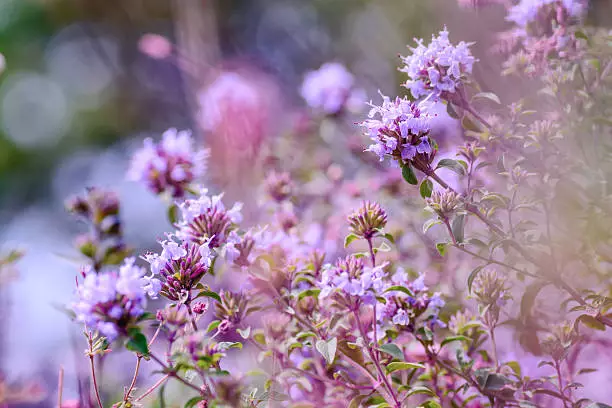
As another purple-flowered herb in the mint family, oregano is both beautiful and useful to the garden and the home. It’s a herb native to the Mediterranean region but is also found in the temperate west and southwestern parts of Europe. The plant can grow to a height of 80 cm and has spade-shaped leaves that are olive-green in color.
Its uses include the following:
- Used as a fragrance since it contains thymol, pinene, limonene, carvacrol, ocimene, and caryophyllene.
- Added to food for nutrition as it has good amounts of calories, calcium, magnesium, fiber, iron, manganese, potassium, and vitamins K and E.
- Has anti-inflammatory and antibacterial properties and can thus be used in many places and on many illnesses.
- Aids maintain good bone structure.
- Protects the body from free radicals and their effects.
- Slows and prevents cancer progression.
- Improves oral health.
- Added to flavor foods such as pasta and pizza, meats, and bread.
Its growing conditions are as follows:
- Sunlight – full and direct sunlight.
- Soil – well-drained.
Oregano can also be raised indoors under the right conditions.
6. Spearmint
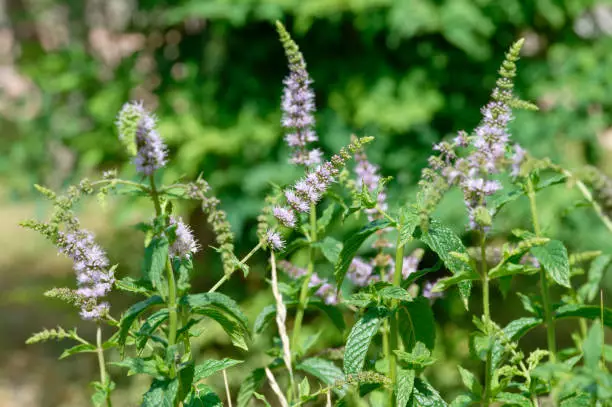
Spearmint is also called common mint, lamb mint, garden mint, or mackerel mint. It’s a native of Turkey and the whole of the Balkan Peninsula although it has been naturalized in the Americas, Africa, Europe, and Asia. Both of its species can grow in these conditions.
The herb is perennial in nature and can grow to 100 cm. Its leaves range from hairy to hairless and have a serrated margin with square-shaped stems. Its flowers are found on slender spikes with a light purple color.
Among its uses include the following:
- Recipe for various foods.
- Added to beverages.
- Used to make mint sauce.
- Added to salads.
- Added to oral health products such as toothpaste and mouthwash.
- Helps with cramp symptoms, sore throat, toothache, headache, indigestion, and gas.
- Packed with lots of vitamins, antioxidants, and other nutrients.
- Has therapeutic properties.
Its growing conditions are as follows:
- Sunlight – partial shade.
- Soil – well-drained, rich, moist at a pH of between 6.5 to 7.
The thing with spearmint is that it needs to be checked frequently since it can easily take over the garden.
7. Chives
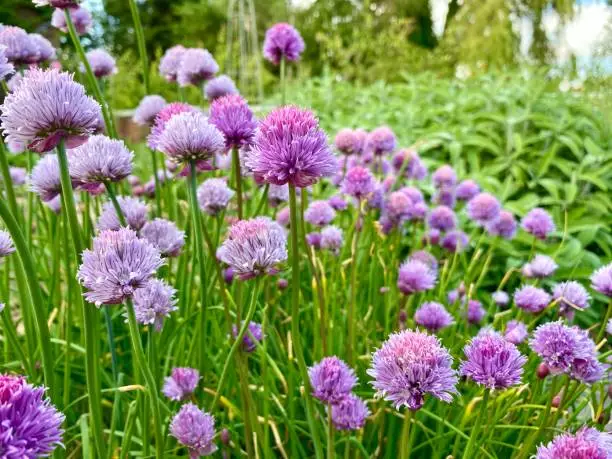
Chives are purple-flowered herbs that are native to Europe, Asia, and North America. Their flowers form in bulb shapes with the plant itself growing to about 50cm high. Their stems are tubular and hollow with a soft texture. Usually, they’re found in dense clusters from their roots. The flowers are found right at the top of the plant.
Some of their uses include:
- They have an onion-like taste and are thus used to garnish soups and added to salads.
- Pest control as they have insect-repelling properties.
- Mood enhancement.
- Improving bone health.
- Cancer prevention.
- Decorations.
Most of the health benefits of this herb are based on its high amount of minerals, vitamins, and antioxidants.
The growing conditions for the herb are as follows:
- Sunlight – full or partial.
- Soil – fertile, well-drained.
- Fertilizer – needs frequent fertilization.
They can be grown in your garden and even indoors.
8. Sage
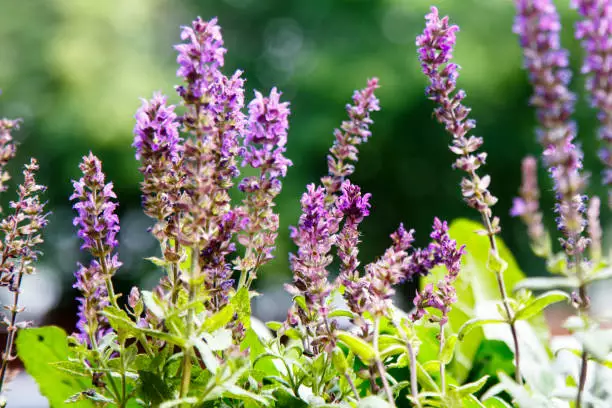
Sage, also called culinary sage, garden sage or common sage is a herb native to the Mediterranean region although it can now be found all over the world. It has small blue to purple flowers with evergreen leaves in gray color. The stems are woody.
Some of its uses are as follows:
- Has a peppery flavor hence found in cuisines in Europe, America, and the Middle East. These include teas, meats, and cheese.
- Alleviates symptoms of Alzheimer’s disease.
- Helps with oral health.
- Aids in the reduction and control of cholesterol and glucose in the blood.
- Reduces menopause symptoms.
- Supports memory and other brain functions.
The health benefits of this herb stem from its having lots of rosmarinic acids, vitamin K, manganese, iron, calcium, and vitamin B6.
The growing conditions for the sage herb include the following:
- Sunlight – full to partial sunlight.
- Water – slight watering.
- Soil – well-drained with a pH between 6 and 7.
- Companion plants – cabbage, tomatoes, strawberries, and carrots.
It’s a relatively hardy herb that doesn’t require much care from you.
9. Tulip
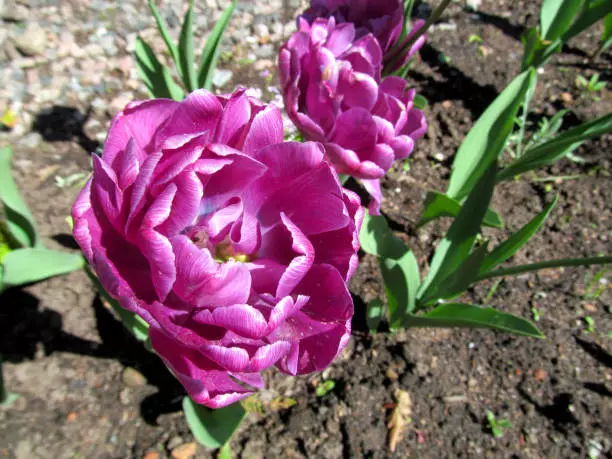
Among the most known flowers with purple color is the tulip. A native of South Europe and Central Asia, the tulip blooms in the spring and has bright-colored flowers in purple, yellow, red, pink, and even white. The flowers are large, symmetric, and can take the shape of cups, bowls, goblets, and many other shapes. They can grow to 71cm in height.
Their uses include the following:
- Used as gifts.
- Used for decorations on bridal bouquets, tables, and general decorations.
- The flowers and bulbs are edible.
- Used as onion replacements in salads.
- Reduce the risk of cancer.
- Provide relief against colds, cough, hay fever, headaches, and sinus pain.
The growing conditions for tulips are as follows:
- Sunlight – full or afternoon sunlight.
- Soil – well-drained, neutral to slightly acidic.
- Shelter from strong winds.
- Spacing – 4 to 6 inches apart.
Tulips are easily the most common purple-flowered herbs during the spring. They’re quite easy to grow as well.
10. Thyme
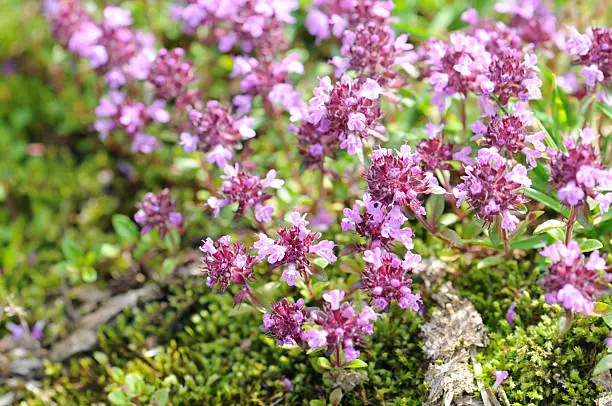
Thyme is a herb native to the Mediterranean region with bright purple flowers. It grows to a height of about 40 centimeters. It’s a bushy evergreen subshrub that has a woody base and small grayish-green leaves. The flowers are at times pink (besides the purple color).
Some of its uses include the following:
- Helps reduce high blood pressure.
- Helps alleviate common skin problems.
- Protects against cancer.
- Kills mosquitos.
- Used in cooking and addition to soups, salads, stocks, and sauces.
- Used in flower arrangements for gift items.
- Used to provide aroma.
It has lots of bitter compounds, organic acids, tannins, minerals, and vitamins A and B.
The growing conditions for thyme are as follows:
- Sunlight – plenty of sunlight.
- Soil – well-drained with pH between 6 and 8.
It can be grown indoors under the right conditions.
11. Peony
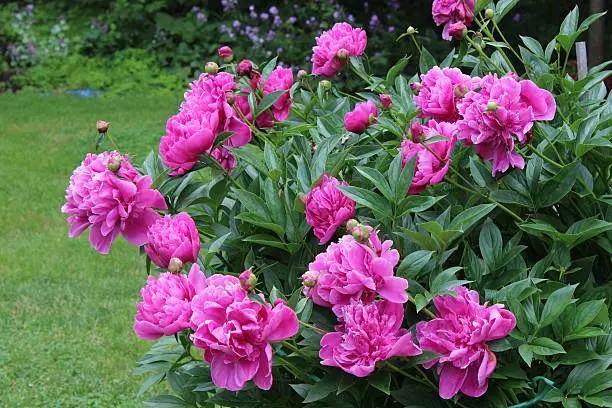
Peony, a herb native to temperate climates around the world, has many unique traits in a single plant. You can find it in regions such as Asia, Europe, and Western North America where it grows either as a deciduous perennial herb or woody shrub.
The flowers of the peony herb are in six types namely single, double, semi-double, bomb, Japanese, and anemone. The colors also range from red, purple, yellow, white, pink, and coral. As can be seen here, you can find peony herbs looking very different even when they’re from the same species.
Some of the uses of this herb include the following:
- Alleviates inflammation.
- Helps control hepatitis enzymes.
- Reduces pain during cramps.
- Prevents the aggregation of platelets in the body.
- Aids in improving fertility in women.
- Used to improve the aesthetics of gardens and homes.
Their growing conditions include the following:
- Sunlight – 6 to 8 hours of sunlight.
- Soil – well-drained, rich, and moist soil.
- Shelter them from strong winds.
With the right conditions, you can grow peony indoors. The major hurdle with indoor conditions is the sunlight which might be less than what the herb needs.
12. Wild indigo
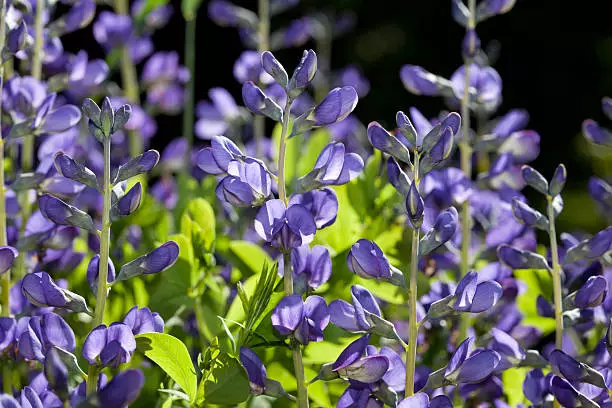
Also called the false indigo, wild indigo is a herb found in the grasslands of southern North America and woodlands of eastern North America. The herb can grow as high as 16 inches with the base being woody and the flowers having a pea-like shape with a color between purple and blue.
Some of its uses include the following:
- Used as a dye for different purposes.
- Helps boost the immune system.
- Helps in injury recovery by helping rebuild the damaged tissue.
- Treats abdominal issues.
- Helps keep good oral hygiene.
- Help treat mouth, nose, and ear infections.
Wild indigo grows well in the following conditions:
- Sunlight – thrives in full sunlight with some shade.
- Soil – well-drained, slightly acidic soils.
It’s a bit difficult replicating these growing conditions indoors although it’s still possible.
13. Echinacea
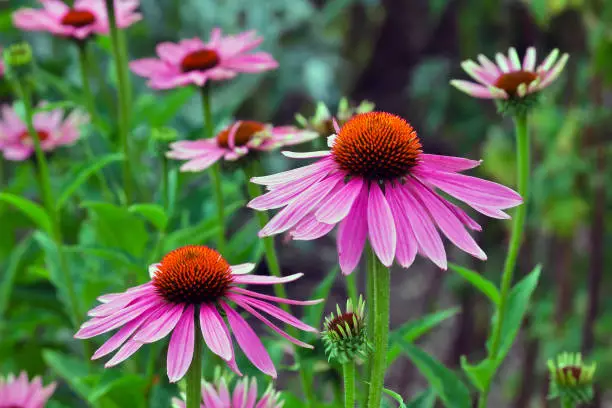
Also called the Purple Coneflower, Echinacea is a perennial flowering herb that blooms from the summer to the early fall. It can grow to about 5 feet in the right conditions. Their flowers are large and have a semblance to sunflowers although echinacea has purple petals around the flower.
Their uses include the following:
- High in antioxidants making it a great addition to health improvement meals.
- Helps improve the immune system.
- Aids lower blood sugar levels.
- Alleviates anxiety.
- Has anti-inflammatory properties thus used to reduce inflammation in the body.
- Aids in keeping healthy skin.
- Offers protection against cancer.
Its growing conditions are as follows:
- Sunlight – full to partial sunlight with at least 4 hours of full sunlight required or day.
- Soil – well-drained soils
- Spacing – varying as per the cultivar
- Planting – in the fall or spring
You can also grow the plant indoors as long as you can replicate the perfect conditions stated here.
14. Christmas basil
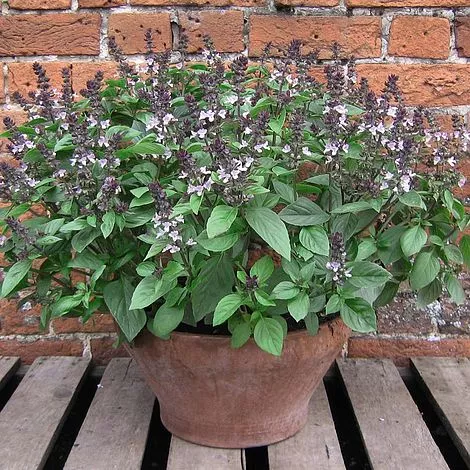
Christmas basil is just one of the many types of herbs in the basil family. It has purple flowers that grow to a height of about 16 inches and is a Thai native. It has large glossy leaves with a fruity smell and blooms in the summer.
Some of its uses are as follows:
- Seasoning foods.
- Eaten directly.
- Cooking.
The growing conditions for this herb are as follow:
- Sunlight – lots of direct sunlight is needed.
- Soil – moist but well-drained.
- Spacing – 10 inches apart.
You can grow the herb indoors but you’ll need lots of light (up to 16 hours a day).
15. Cinnamon basil
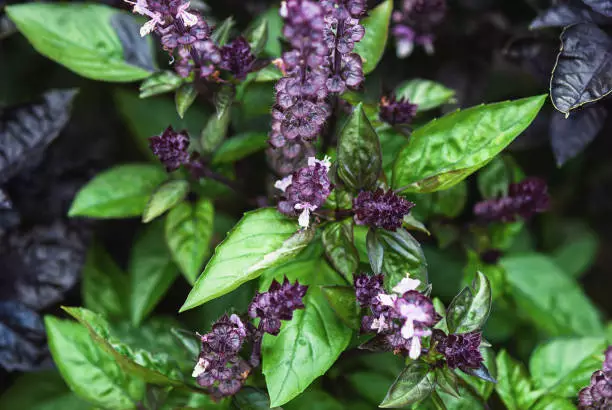
Second, from the basil family is the cinnamon variant which is also called the Mexican spice basil. Due to having methyl cinnamate, it has a taste very similar to that of cinnamon hence the name. The flowers range in color from pink to purple with the leaves being dark-green and shiny with purple veins. It books from July to September.
Among its uses include the following:
- Used in teas.
- Used in baked goods.
- Added to vinegar, salads, jellies, and pasta.
- Used in dried arrangements like potpourri.
The growing conditions for this herb are as follows:
- Sunlight – 6 to 8 hours of direct sunlight each day.
- Combination plants – tomatoes and roses to discourage pests.
It can survive in hardy conditions in hardiness zones 9 to 11.
